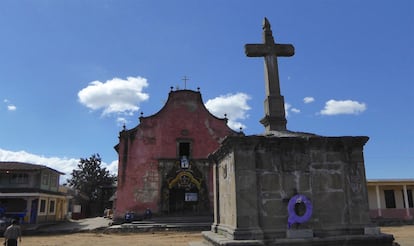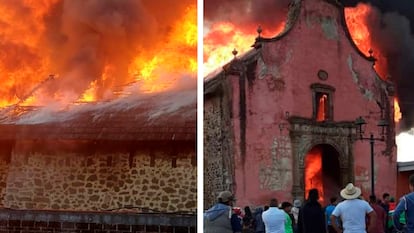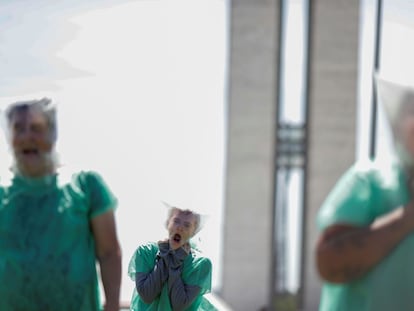Historic church fire ignites debate in Mexico over heritage budgets
Previous incidents had threatened the Apostle Santiago Church in Michoacán state, but with the place of worship burned to the ground, finger-pointing has begun

When the Apostle Santiago Church in Nurio, Michoacán state, went up in smoke on March 7, few could say they hadn’t seen it coming. Flames have licked the walls of this historic temple several times before, but were always extinguished before major damage was done. This time a blaze has destroyed a piece of Mexican heritage permanently, and the recriminations have begun.
Just a shell of four walls remains of the place of worship built by Spanish missionaries in one of Michoacán’s indigenous Purépecha areas in the 16th century, with charred wooden beams littering the ground. Santiago, or Saint James, is the patron saint of this area, home to 5,000 people.
Michoacán state’s culture body had projects underway to preserve the church, but these were tragically late to be implemented
The cause of the fire that broke out on a Sunday evening is unknown, but the loss is irreparable. The World Monuments Fund described the church’s interior as “elaborately decorated in the Mexican Baroque style, which combined mudéjar carpentry and... a pre-Hispanic painting method that incorporates natural oils and minerals.” Indigenous art adorned the walls, and while neighbors were able to remove some objects of value, the majority of this history is gone.
Mexico’s National Institute of Anthropology and History (INAH) and Michoacán state’s culture body had projects underway to preserve the church, but these were tragically late to be implemented.
Representatives of the town met with culture officials on Monday and asked for explanations for the delay. The anger was palpable. “The local authorities criticized INAH because they did not meet their deadlines. By January 8 they should already have started their projects,” said the mayor of the nearby town of Paracho, José Manuel Caballero, who also oversees the locality of Nurio. Almost everyone agreed on one culprit: the barebones culture budget. Michoacán State Secretary for Culture Claudio Méndez conceded this in a telephone interview. “[The firefighters] could not even direct the jet of water against the stone walls, because we did not know if they would hold,” he said. “Fortunately we have records to copy the paintings of the artists of the time and the interior decoration,” he added. The Covid-19 pandemic has only aggravated shortages to culture budgets. Méndez also warned that the Apostle Santiago Church was not the only place of worship in danger in the area.

Now the task will not be one of restoration or conservation, but of reconstruction. Wood has already been sent to the town to shore up the structure and INAH insurance experts will arrive soon. An insurance payout will be essential to start rebuilding, though some funds will also come from the Michoacán state budget and from the federal government.
“The terrible reality is the low budgets we have, said INAH delegate to Michoacán Marco Rodríguez. The townspeople had requested reinforcements for the roof for some time, but historic buildings of this kind require specific care that is expensive.
Nelly Sigaut, an art historian at the Colegio de Michoacán, said the tragedy had “wrung out” her heart. Priests to whom she gives heritage classes had tears in their eyes when greeted with the news. “This is a treasure that was unique in the world, singular in its style,” Sigaut said. “They call it the Sistine Chapel of the Plateau, and they weren’t exaggerating,” she added, referring to Michoacán’s Purépecha Plateau. She recalled with sadness the angels with musical instruments painted onto the main altar.
The church was part of a hospital complex built by the Spanish bishop of Michoacán, Vasco de Quiroga, and the rest of the architectural ensemble survives. But tourists are hard to come by in an area plagued by insecurity. Visitors who had the luck to visit over the years have only their memories to comfort them today.

Tu suscripción se está usando en otro dispositivo
¿Quieres añadir otro usuario a tu suscripción?
Si continúas leyendo en este dispositivo, no se podrá leer en el otro.
FlechaTu suscripción se está usando en otro dispositivo y solo puedes acceder a EL PAÍS desde un dispositivo a la vez.
Si quieres compartir tu cuenta, cambia tu suscripción a la modalidad Premium, así podrás añadir otro usuario. Cada uno accederá con su propia cuenta de email, lo que os permitirá personalizar vuestra experiencia en EL PAÍS.
¿Tienes una suscripción de empresa? Accede aquí para contratar más cuentas.
En el caso de no saber quién está usando tu cuenta, te recomendamos cambiar tu contraseña aquí.
Si decides continuar compartiendo tu cuenta, este mensaje se mostrará en tu dispositivo y en el de la otra persona que está usando tu cuenta de forma indefinida, afectando a tu experiencia de lectura. Puedes consultar aquí los términos y condiciones de la suscripción digital.
More information
Archived In
Últimas noticias
Rowan Atkinson tops Netflix at 70: ‘He’s as funny as ever’
Israeli recognition of Somaliland stirs up the Gulf
Tiger Woods turns 50: Will he continue playing on the PGA Tour or take a back seat?
The surreal journey of James Nnaji, the Barcelona youth player selected in the NBA Draft who ended up in the NCAA
Most viewed
- Oona Chaplin: ‘I told James Cameron that I was living in a treehouse and starting a permaculture project with a friend’
- Reinhard Genzel, Nobel laureate in physics: ‘One-minute videos will never give you the truth’
- Sinaloa Cartel war is taking its toll on Los Chapitos
- Why the price of coffee has skyrocketed: from Brazilian plantations to specialty coffee houses
- Chevy Chase, the beloved comedian who was a monster off camera: ‘Not everyone hated him, just the people who’ve worked with him’











































